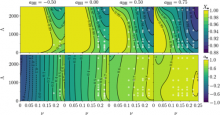
Abstract
Observations of gravitational waves and their electromagnetic counterparts may soon uncover the existence of coalescing compact binary systems formed by a stellar-mass black hole and a neutron star. These mergers result in a remnant black hole, possibly surrounded by an accretion disk. The mass and spin of the remnant black hole depend on the properties of the coalescing binary. We construct a map from the binary components to the remnant black hole using a sample of numerical-relativity simulations of different mass ratios q, (anti-)aligned dimensionless spins of the black hole aBH, and several neutron star equations of state. Given the binary total mass, the mass and spin of the remnant black hole can therefore be determined from the three parameters (q,aBH,Λ), where Λ is the tidal deformability of the neutron star. Our models also incorporate the binary black hole and test-mass limit cases and we discuss a simple extension for generic black hole spins. We combine the remnant characterization with recent population synthesis simulations for various metallicities of the progenitor stars that generated the binary system. We predict that black-hole-neutron-star mergers produce a population of remnant black holes with masses distributed around 7M⊙ and 9M⊙. For isotropic spin distributions, nonmassive accretion disks are favoured: no bright electromagnetic counterparts are expected in such mergers.